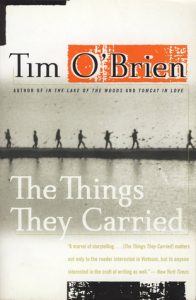
 Literature Guides
Literature Guides
The Things They Carried Summary
Summary
“Tim O’Brien”, the protagonist of The Things They Carried, starts by recalling a specific event that occurred in the midst of his experience in the Vietnam war setting. The novel describes the collection of things that his fellow soldiers in the Alpha Company brought along with them on their many missions. Some, for example, carried with them tremendous guilt or fear of the unknown. Where others brought along things like matches, morphine, M-16’s or even candy.
As the book progresses, multiple characters resurface in various stories. The first soldier in the Alpha Company to meet his fate is a grunt by the name of Ted Lavender. Ted frequently deals with his anxiety and trepidations about the war by consuming sedatives and smoking marijuana.
On his way back from the latrine one day, Ted is shot in the head. His superior, Jimmy Cross, immediately blames himself for the death because he had been distracted of thought of his college crush, Martha, when the tragedy occurred. In “Love” it is revealed that the love Cross had for Martha, whom he had dated prior to leaving for the Vietnam war, had never been reciprocated. And, that even twenty years after the war had ended, Cross still carries the guilt he felt over the death of Lavender.
Whilst narrating in “On the Raining River” O’Brien explains the chain of events that resulted in him leaving for Vietnam to begin with. His draft notice came in June of 1968, consumed by confusion and fear he made his way north to the Canadian border, where he contemplated crossing so that he would not be forced to take up arms in a war that he did not believe in. O’Brien finds himself sitting in a rowboat with the owner of Tip Top Lodge, where he had been staying.
O’Brien soon decides that his fear of disappointing his family and his guilt about the avoiding the war are far more important than his own political beliefs. Not much time passes before he leaves, first going back to his home in Worthington, Minnesota and later to Vietnam.
Ted Lavender is not the only Alpha Company member who his killed during their mission overseas: Curt Lemon loses his life after stepping on a rigged mortar round, and, despite not having been particularly close to Lemon, in “The Dentist” O’Brien tells of how Lemon would faint before a routine checkup with the army dentist. One day, in an attempt to save his face, Lemon insisted the Dentist pull out a perfectly healthy tooth.
Lee Strunk, another soldier in the Company, dies after stepping on a landmine. In “Friend” O’Brien tells of a pact that Strunk and Dave Jensen had made, prior to Strunk’s death, with each man promising the other that if one of them were to be mortally injured, the other would take measures to see that death came quickly. Even so, when Strunk was fatally wounded, he pleaded with Jensen to spare him, Jensen of course complies. Rather than being upset over the news of his friend’s hasty death en route to the infirmary, Jensen is overcome with relief.
The death that receives the greatest amount of attention is that of O’Brien’s closest friend in the Alpha Company, Kiowa. In “Speaking of Courage”, Kiowa’s death is relayed in recollection of Norman Bowker several years after the end of the war. As Bowker travels around a lake in his hometown in Iowa, he discloses that he believes he failed to save Kiowa, who was killed after being hit by a mortar round.
It is then when O’Brien comes to the realization that he has dealt with the guilt of Kiowa’s death differently than Bowker had. Just before the war ended, O’Brien receives a multi-page letter from Bowker explaining that he has not been able to finding meaning in his life after the war. O’Brien promises to share Bowker’s story, and also the story of Kiowa’s death, in hopes of being better able to understand his own feelings and the guilt he is plagued with.
Similar to “Love” and “Notes” many of O’Brien’s stories are told as if it were twenty years since the end of the war, during a time when he is a forty-three-year-old writer living in Massachusetts. Being exposed to the guilt that his friends had suffered had encouraged him to write his own stories in hopes of better understanding what they had been conflicted with.
But, two stories “The Man I Killed” and “Ambush” were actually written so that O’Brien could face his own guilt of having take a man’s life outside the village of My Khe. In “The Man I Killed”, O’Brien fantasizes about the life of the man he killed, thinking of him from childhood and wondering what direction his life might have taken had O’Brien not thrown a grenade in his direction.
In “Ambush”, O’Brien wonders how he might tell the story of the man he had killed to his daughter Kathleen, who was just nine years old. In this story, O’Brien offers more details into the killing itself – including what the grenade sounded like and his own feelings. He goes on to explain that he has not yet been able to deal with the memories its left behind.
In the final story, “The Lives of the Dead”, O’Brien presents a twist to his argument that stories have the capability to save people. In the stories told about Kiowa and Curt Lemon, O’Brien explains that his own imagination had allowed him to suppress his guilt and confusion over the death of his first love, Linda.



